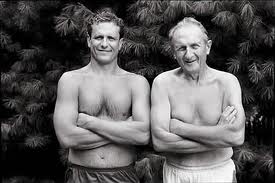On Tuesday our Foundation class went on a trip to Oxford, to look at galleries, museums, buildings, and to draw, whatever. For me it was something of a nostalgia trip. I think my last visit to Oxford was in about 1972 when I was a student and visiting quite regularly. So it was nice to go back, especially on a beautiful crisp and sunny autumn day, and to find that the city and the university rally hasn't changed at all. I wandered through Jericho and found old haunts, dissevered the Little Clarendon Street is no longer as quaint and pretty as it was, but that St Giles churchyard is as lovely and peaceful as ever, despite begin surrounded by main roads. Lots of bikes, of course, and lots of busy-looking students. It is early in the new term, so there seemed to be a lot of young people surreptitiously consulting maps and directions, as of course were the tourists, although there weren't too many of those about.
First I went to the Natural History Museum, which has an impressive array of skeletons and fossils, from the tiny to the enormous.
The building itself is a little like a miniature version of the London natural history Museum. Amazing building, on a steel frame, rather like a London railway station, but the steels are all decorated, very William Morris...
Outside, there are dinosaur footprints in the grass, and huge tree roots brought from rain forests in South East Asia and similarly wild places.
You have to go through the Natural History Museum to reach the wonders of the Pitt Rivers collection, which was almost overwhelming in its range and diversity, and the sheer quantity of material it holds. All jumbled together in big glass cases, with labels apparently written in longhand in the 1870s, and not much sign of anything having changed or been added since about 1900. I presume someone opens the cases and removes the dust form time to time, although even that seemed doubtful in some of them, where a layer of fine dust seemed to cling to every surface.
I had meant to draw, but in practice the lighting is very low, and the cases are so crammed with objects, and the overall effect is so clamourous, that I found I could not focus or concentrate. Among the things which particularly entranced me were the decorated earthenware pots
the stencils made from palm leaves
and the amazing ceremonial heads and masks.
So I went off in search of lunch, and found Blackwells bookshop on The Broad, where I rewarded myself with a very nice sandwich and some growing and only 3 small book purchases. Blackwells is huge and worth a day in itself.
Suitable refreshed, I wandered on to the Ashmolean. To my shame I never ventured inside when I was a student visitor (nor to Pitt Rivers, either). The Ashmolean has undergone extensive recent alterations and extension, and ins now a beautifully light and airy gallery space, with a mixture of classical museum fare and a good collection of European and British art. I did not have huge amount of time, so I concentrate on the lower ground floor (including textiles, writing implements) and the 20th century art on the top floor. There is a room full of 20th century British painting - Spencer, Piper, Nicholson, etc, etc; and a room of mainly Pissarro and other Impressionists. Absolutely lovely, and in a gallery full of natural light and space. the contrast between the 'less is more' approach of the Ashomlean and the 'cram it all in' style of the Pttt Rivers was quite striking. The Ashomlean won, hands down.
I spotted an interesting installation made by a collaboration of local school children - a kind of patchwork ceramic wall, made of a series of small tiles, each with a relief of a small object, toy, key, whatever. It looked even better in real life....
I didn't get much drawing done, but I saw lots, and got a good feel for he range of objects and art available, and I shall go again, before long, under my own steam and take in slightly less scope but in more depth. A very successful and stimulating day.


































